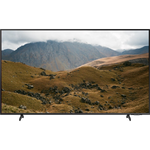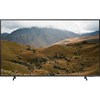A comparison of specs, key information, reviews, and best pricing from top retailers
Last updated -- hours ago | Report incorrect information
What we think

The PerfectRec TV team Learn more
Updated January 12, 2024·
The Samsung Q60A offers good value if you're looking for a solid TV without spending too much; it's suitable for casual viewing and has a decent overall picture quality. On the other hand, the Sony X93L, while more expensive, offers superior picture quality, better motion handling, and is a better choice for sports and action-packed movies or games, especially in brighter rooms. If you're looking for a high-quality cinematic experience or a TV that can keep up with fast-paced content, and are willing to pay a premium for it, then the Sony X93L would be the better option. Give Feedback
this description is based on the product variant with some specs and product variant with some specs. At the time of writing, the variant with some specs cost some dollars and the variant with some specs cost some dollars.
Advantages of the Samsung Q60A (LCD)
- The Samsung Q60A (LCD) has no clear advantages over the Sony X93L (LCD).
Advantages of the Sony X93L (LCD)
- Excellent for bright room
- Good for dark room
- Very good for gaming
- Good for movies & TV
- Very good for sports
- Very good for news, talk, & other TV
- Good for use as monitor
- Best in class for upscaling
- Best in class motion processing
- Very good reflections
Key differences
Picture Quality
7.2


7.9
7.13/10
CONTRAST
7.00/10
7.7/10
COLOR VOLUME SCORE
8.7/10
LED
PANEL TYPE
miniLED FALD
VA
PANEL SUB-TYPE
VA
The Sony X93L (LCD) and Samsung Q60A (LCD) both have good picture quality, though the Sony X93L (LCD) has somewhat better picture quality.
Movies & TV
6.5


7.9
7.13/10
CONTRAST
7.00/10
7.2/10
BLACK UNIFORMITY
6.7/10
7.0/10
UPSCALING
10.0/10
Yes
HDR10 SUPPORT
Yes
Yes
HDR10+ SUPPORT
No
No
DOLBY VISION SUPPORT
Yes
The Sony X93L (LCD) is good for movies & TV, while the Samsung Q60A (LCD) is only fair.
The Sony X93L delivers a more engaging experience for movies and cinematic TV due to its superior contrast, local dimming, and black uniformity, which enable deeper blacks and more detailed shadows—important for dark scenes. In contrast, while the Samsung Q60A offers decent performance, its lower levels of black uniformity and the absence of local dimming mean it can't match the depth and detail in darker scenes that the Sony provides.
Sports
6.5


8.0
7.0/10
MOTION PROCESSING
10.0/10
60Hz
REFRESH RATE
120Hz
10.0/10
INPUT LAG SCORE
7.0/10
7.0/10
UPSCALING
10.0/10
8.2/10
SDR BRIGHTNESS SCORE
9.0/10
Yes
HLG SUPPORT
Yes
The Sony X93L (LCD) is very good for sports, while the Samsung Q60A (LCD) is only fair.
The Sony X93L is rated higher for sports watching than the Samsung Q60A due to its superior motion processing and faster response time, which result in a clearer picture with less blur during fast action. Additionally, the Sony X93L handles reflections better and has a wider viewing angle, which helps maintain the image quality when watching from different positions around the room.
Gaming
5.6


8.3
5.7/10
RESPONSE TIME SCORE
8.3/10
10.0/10
INPUT LAG SCORE
7.0/10
7.0/10
MOTION PROCESSING
10.0/10
0.0/100
GAMING LOCAL DIMMING
85.0/100
6.9/10
GAME HDR BRIGHTNESS SCORE
8.8/10
The Sony X93L (LCD) is very good for gaming, while the Samsung Q60A (LCD) is poor.
The Samsung Q60A has poor response time, which might result in blurry images during fast-moving scenes, but it has the best input lag, which is great for gaming responsiveness. In comparison, the Sony X93L's very good response time ensures sharper images when gaming, although its input lag isn't rated as highly as the Q60A's, it's still good for gaming and is coupled with excellent sound quality.
News, Talk, & Other TV
7.3


8.9
8.2/10
SDR BRIGHTNESS SCORE
9.0/10
7.0/10
UPSCALING
10.0/10
The Sony X93L (LCD) is very good for news, talk, & other TV, while the Samsung Q60A (LCD) is good.
The Samsung Q60A delivers very good SDR brightness and upscaling, making it suitable for watching news and TV programs, especially in brighter rooms, and its colors out of the box are good, which means less need for calibration. On the other hand, the Sony X93L offers excellent SDR brightness, which stands out in well-lit environments, and superior upscaling quality for watching lower-resolution content, while also providing good colors out of the box.
Bright Room
7.2


9.4
5.4/10
VIEWING ANGLE
5.8/10
8.2/10
SDR BRIGHTNESS SCORE
9.0/10
7.0/10
HDR BRIGHTNESS SCORE
8.9/10
6.3/10
REFLECTIONS SCORE
8.4/10
The Sony X93L (LCD) is excellent for bright room, while the Samsung Q60A (LCD) is good.
Cost
$498


$1,798
$0
$500
$1,000
$1,500
$2,000
$2,500
$3,000
The Samsung Q60A (LCD) has a price of $498 and the Sony X93L (LCD) costs $1,798.

Let Us Help Find Your Perfect TV
Find your new TV
Key similarities
Cartoons & Animation
8.2


8.5
7.5/10
COLOR GAMUT SCORE
7.6/10
7.7/10
COLOR VOLUME SCORE
8.7/10
8.2/10
SDR BRIGHTNESS SCORE
9.0/10
8.1/10
COLORS OUT OF THE BOX SCORE
7.8/10
7.0/10
GRAY UNIFORMITY
8.2/10
The Sony X93L (LCD) and Samsung Q60A (LCD) are both very good for cartoons & animation.
The Samsung Q60A delivers very good colors straight out of the box, providing a vibrant viewing experience for cartoons and animations without the need for extensive calibration. In comparison, the Sony X93L offers a similarly strong performance in color reproduction, ensuring that animations appear vivid and engaging, with the advantage of a more comprehensive color volume that enhances the range of hues on display.
Give feedback
We’re constantly working to improve.
How the Samsung Q60A (LCD) and the Sony X93L (LCD) compare to other TVs
Spec Comparison
| Samsung Q60A (LCD) | Sony X93L (LCD) |
GENERAL | |||
|---|---|---|---|
| Price | |||
$498 | $1,798 | ||
Brand | |||
Brand | Samsung | Sony | |
Release Date | |||
Release Date | March 1, 2021 | June 1, 2023 | |
Full name | |||
Full name | QN32Q60A | XR-65X93L | |
Screen Size | |||
Screen Size | 32" | 65" | |
Screen Resolution | |||
Screen Resolution | 1080P | 4K | |
TV FEATURES | |||
|---|---|---|---|
Operating System | |||
Operating System | Tizen | Google TV | |
Sound Quality Score | |||
Sound Quality Score | 5.6/10 | 9.2/10 | |
NextGen Ready | |||
NextGen Ready | No | Yes | |
HDMI Ports | |||
HDMI Ports | 3 | 4 | |
Coax Ports | |||
Coax Ports | 1 | 1 | |
DISPLAY QUALITY SCORES | |||
|---|---|---|---|
Picture Quality Score | |||
Picture Quality Score | 7.3/10 | 8/10 | |
Bright Room Score | |||
Bright Room Score | 7.2/10 | 9.4/10 | |
Gaming Score | |||
Gaming Score | 5.6/10 | 8.3/10 | |
Movies & TV Score | |||
Movies & TV Score | 6.6/10 | 7.9/10 | |
Sports Score | |||
Sports Score | 6.5/10 | 8.1/10 | |
PHYSICAL | |||
|---|---|---|---|
Dimensions w/o Stand (H x W x D) | |||
Dimensions w/o Stand (H x W x D) | 16.8" x 28.5" x 1.2" | 32.9" x 56.9" x 2.4" | |
Dimensions with Stand (H x W) | |||
Dimensions with Stand (H x W) | 18.8" x 28.5" | 33.4" x 56.9" | |
Weight without Stand | |||
Weight without Stand | 11.7 lbs | 70.8 lbs | |
VESA Mount | |||
VESA Mount | 100 x 100 | 300 x 300 | |
DISPLAY | |||
|---|---|---|---|
Color Depth | |||
Color Depth | 10 bit | 10 bit | |
Black Frame Insertion | |||
Black Frame Insertion | No | Yes | |
Auto Low Latency Mode | |||
Auto Low Latency Mode | No | Yes | |
Contrast | |||
Contrast | 7.1/10 | 7/10 | |
Local Dimming | |||
Local Dimming | 3/10 | 7.6/10 | |
SOUND | |||
|---|---|---|---|
Speaker Setup | |||
Speaker Setup | 2.0 | 2.2 | |
Speaker Power | |||
Speaker Power | 20 W | 60 W | |
Dolby Atmos | |||
Dolby Atmos | Yes | Yes | |
DTS:X | |||
DTS:X | No | Up to DTS Digital Surround, Bypass only | |
Shopping
Samsung Q60A (LCD)
See more
Dig into reviews and images
CNET
Geoffrey Morrison | June 2021
"The least expensive QLED is a solid choice for Samsung fans. Right out of the gate my eye was drawn to the Samsung. It is bright. The quantum dots let the Q60A produce far deeper, richer colors than the Vizio and TCL"
Get a great deal on the Samsung Q60A (LCD) or the Sony X93L (LCD)
About Samsung
Samsung, a South Korean electronics manufacturer, holds the title of being the largest global TV vendor in terms of units sold. They offer a diverse lineup of TV products that cater to various budget ranges. A notable achievement in recent years is the development of Quantum Dots, a technology that enhances color reproduction, resulting in richer and more vibrant hues. Samsung TVs are well-regarded for their high manufacturing quality and user-friendly software, making them an excellent choice for consumers seeking an intuitive viewing experience.
About Sony
Sony stands as a highly experienced and widely trusted TV manufacturer, earning a reputation that surpasses all others. A Japanese company, Sony has been making TVs for far longs than it has been making Playstation game consoles. Sony's high-end TVs are often regarded as the ultimate choice for videophiles, representing the epitome of quality, albeit at a premium price point. Renowned for their advanced and precise motion handling, as well as their cutting-edge local dimming algorithms, Sony consistently delivers unparalleled performance in these areas. They include Google TV software with all their TV sets, which grants access to the largest selection of apps available and they also include Bravia Core which is a movie streaming platform specifically for Sony TVs that offers higher picture quality by using more bandwidth.
Give feedback
We're constantly perfecting our model
TV guides you might be interested in
More comparisons for you
FAQs
FAQs about TVs
Why trust us
This information was produced and vetted by the PerfectRec TVs team. We are a product research and recommendation organization that meticulously reviews and evaluates the latest TV information and makes it digestible for you.
By the numbers
385
TVs evaluated
33,110
TVs stats compiled
21
Proprietary TVs ratings developed
122,430
Recommendations made
18,365
Consumer hours saved
About the TV team
Joe Golden, Ph.D
CEO and TVs Editor
Joe is an entrepreneur and lifelong electronics enthusiast with a Ph.D in Economics from the University of Michigan.
Jason Lew
Staff Expert & Software Engineer
Jason is a staff expert and software engineer that has been making laptop recommendations for 7 years and moderates one of the largest laptop subreddits.
Chandradeep Chowdhury
Staff Expert & Software Engineer
Chandradeep is a staff expert and software engineer and expert in televisions and monitors. He’s been making monitor recommendations for ten years.
Jaime Roldán
TVs Expert
Jaime is a Colombia-based TV expert. He is an electronics engineer with 8 years of experience in the telecom sector and has been making TV recommendations for 12 years.







